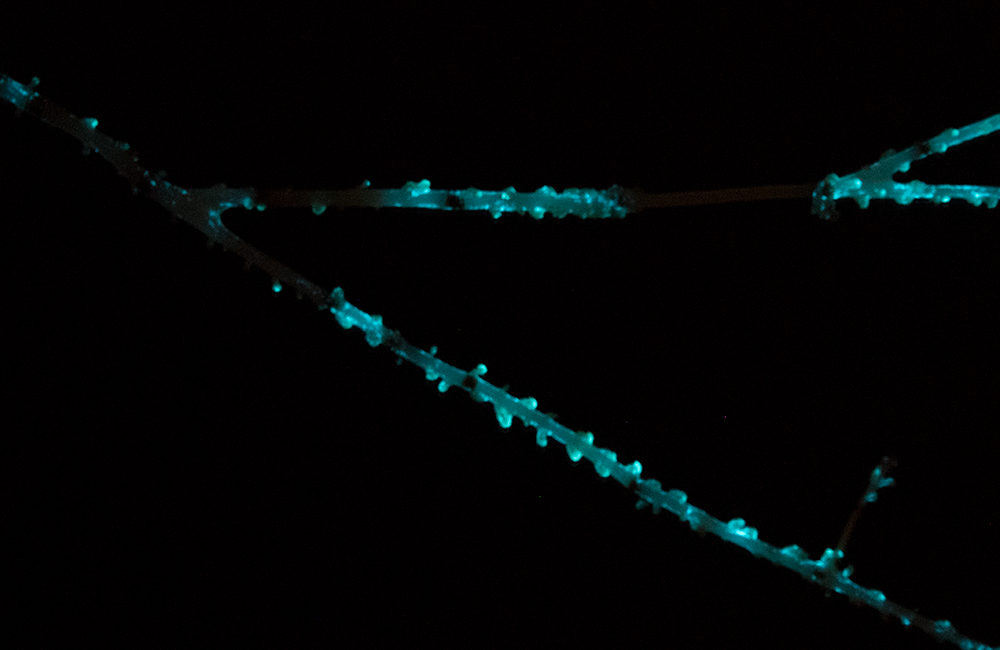Fishing for enzymes deep in the ocean
When a research team pulls up a trawling net from the ocean floor, researchers often scramble to douse the specimens in ethanol or formaldehyde. It’s important to prevent decay of organisms that usually die before they even reach the surface. But Anderson Garbuglio de Oliveira, a chemist studying marine bioluminescence, would rather they were frozen.

“If you throw a net in the ocean, you will probably find a lot of bioluminescent organisms,” he said. About 90% of deep sea species produce light; but that glow is almost invisible in bright daylight, and his shipboard colleagues are usually interested in other topics. To retrieve and freeze bioluminescent tissue samples before they are pickled in formaldehyde, he said, “I must be very quick.”
Back in the lab at the University of Sao Paulo, Oliveira’s research team investigates the activity of luciferase enzymes, which produce light through a reaction between oxygen and a family of substrate molecules. While some luminescence systems, such as those from comb jellies, are well understood, working with other organisms, such as segmented worms, is “very, very difficult,” Oliveira said, “because their systems are completely new. … Most of the time you have no idea what you’re dealing with.”
Biotechnologists have found numerous laboratory uses for the best-known luciferases, which come from jellies and fireflies. Still, surprisingly little is known about the other biochemical systems that produce light, a phenomenon that evolved on at least 94 independent occasions.
Oliveira is looking for enzymes with properties that could be biochemically interesting and lead to novel uses, such as detecting magnesium or calcium without needing to use fluorescence microscopy. He said, “You can find a lot of interesting things in these weird animals.”
Enjoy reading ASBMB Today?
Become a member to receive the print edition four times a year and the digital edition monthly.
Learn moreGet the latest from ASBMB Today
Enter your email address, and we’ll send you a weekly email with recent articles, interviews and more.
Latest in Science
Science highlights or most popular articles

Bacteriophage protein could make queso fresco safer
Researchers characterized the structure and function of PlyP100, a bacteriophage protein that shows promise as a food-safe antimicrobial for preventing Listeria monocytogenes growth in fresh cheeses.

Building the blueprint to block HIV
Wesley Sundquist will present his work on the HIV capsid and revolutionary drug, Lenacapavir, at the ASBMB Annual Meeting, March 7–10, in Maryland.

Gut microbes hijack cancer pathway in high-fat diets
Researchers at the Feinstein Institutes for Medical Research found that a high-fat diet increases ammonia-producing bacteria in the gut microbiome of mice, which in turn disrupts TGF-β signaling and promotes colorectal cancer.

Mapping fentanyl’s cellular footprint
Using a new imaging method, researchers at State University of New York at Buffalo traced fentanyl’s effects inside brain immune cells, revealing how the drug alters lipid droplets, pointing to new paths for addiction diagnostics.

Designing life’s building blocks with AI
Tanja Kortemme, a professor at the University of California, San Francisco, will discuss her research using computational biology to engineer proteins at the 2026 ASBMB Annual Meeting.

Cholesterol as a novel biomarker for Fragile X syndrome
Researchers in Quebec identified lower levels of a brain cholesterol metabolite, 24-hydroxycholesterol, in patients with fragile X syndrome, a finding that could provide a simple blood-based biomarker for understanding and managing the condition.

